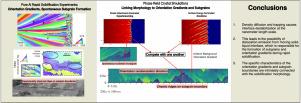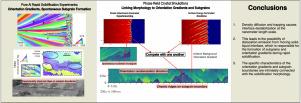Interface morphology and dislocation-mediated processes during rapid solidification of thin films
IF 9.3
1区 材料科学
Q1 MATERIALS SCIENCE, MULTIDISCIPLINARY
引用次数: 0
Abstract
Rapid solidification experiments have, in recent years, revealed a wealth of new microstructural phenomena that suggest a strong connection between the kinetics of solidification and the crystalline structures that emerge as a result. In this work, we investigate the interplay between interface morphology and defect-mediated processes during rapid solidification conditions using a Phase Field Crystal (PFC) model, enabling us to simultaneously and efficiently explore the physics of solidification and elasto-plasticity in the formalism of a single-field theory. We predict that there are two mechanisms by which dislocations emitted directly from the solid–liquid interface induce orientation gradients as well as the formation of subgrain boundaries within a single solidifying cell. We relate these mechanisms to the morphology of the moving solid–liquid interface and identify a suitable control parameter in the PFC model with which we can go between said morphologies by effectively changing the relative strength of the capillary length and kinetic coefficients of the solid–liquid interface. Thus, we are able to provide mechanistic explanations for several microstructural features (with an emphasis on orientation gradients and subgrain boundaries) observed during the rapid solidification of pure materials. We also provide a simple explanation for the formation of “jagged” subgrain boundaries, which is consistent with our experimental observations in rapidly solidified samples of Aluminum, whose mechanisms have thus far been unknown.


薄膜快速凝固过程中的界面形态和位错介导过程
近年来,快速凝固实验揭示了大量新的微观结构现象,表明凝固动力学与由此产生的晶体结构之间存在着密切的联系。在这项工作中,我们使用相场晶体(PFC)模型研究了快速凝固条件下界面形态和缺陷介导过程之间的相互作用,使我们能够在单场理论的形式体系中同时有效地探索凝固和弹塑性的物理特性。我们预测有两种机制,通过从固液界面直接发射的位错诱导取向梯度以及在单个凝固单元内形成亚晶界。我们将这些机制与移动固液界面的形态联系起来,并在PFC模型中确定一个合适的控制参数,通过有效地改变毛细管长度的相对强度和固液界面的动力学系数,我们可以在所述形态之间切换。因此,我们能够为纯材料快速凝固过程中观察到的几个微观结构特征(重点是取向梯度和亚晶界)提供机理解释。我们也为“锯齿状”亚晶界的形成提供了一个简单的解释,这与我们在快速凝固的铝样品中的实验观察一致,其机制迄今为止尚不清楚。
本文章由计算机程序翻译,如有差异,请以英文原文为准。
求助全文
约1分钟内获得全文
求助全文
来源期刊

Acta Materialia
工程技术-材料科学:综合
CiteScore
16.10
自引率
8.50%
发文量
801
审稿时长
53 days
期刊介绍:
Acta Materialia serves as a platform for publishing full-length, original papers and commissioned overviews that contribute to a profound understanding of the correlation between the processing, structure, and properties of inorganic materials. The journal seeks papers with high impact potential or those that significantly propel the field forward. The scope includes the atomic and molecular arrangements, chemical and electronic structures, and microstructure of materials, focusing on their mechanical or functional behavior across all length scales, including nanostructures.
 求助内容:
求助内容: 应助结果提醒方式:
应助结果提醒方式:


